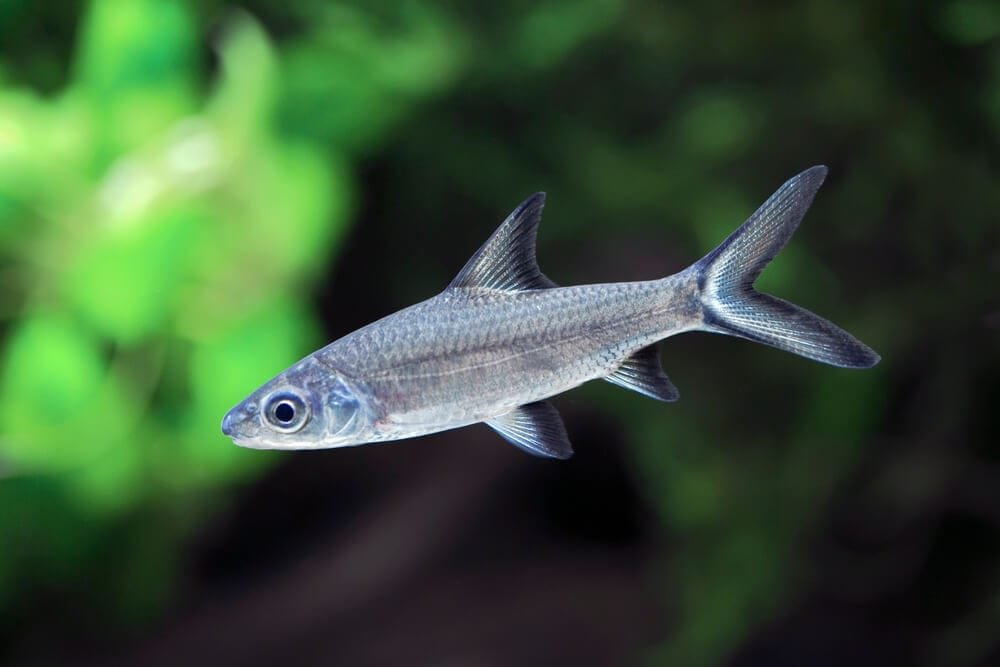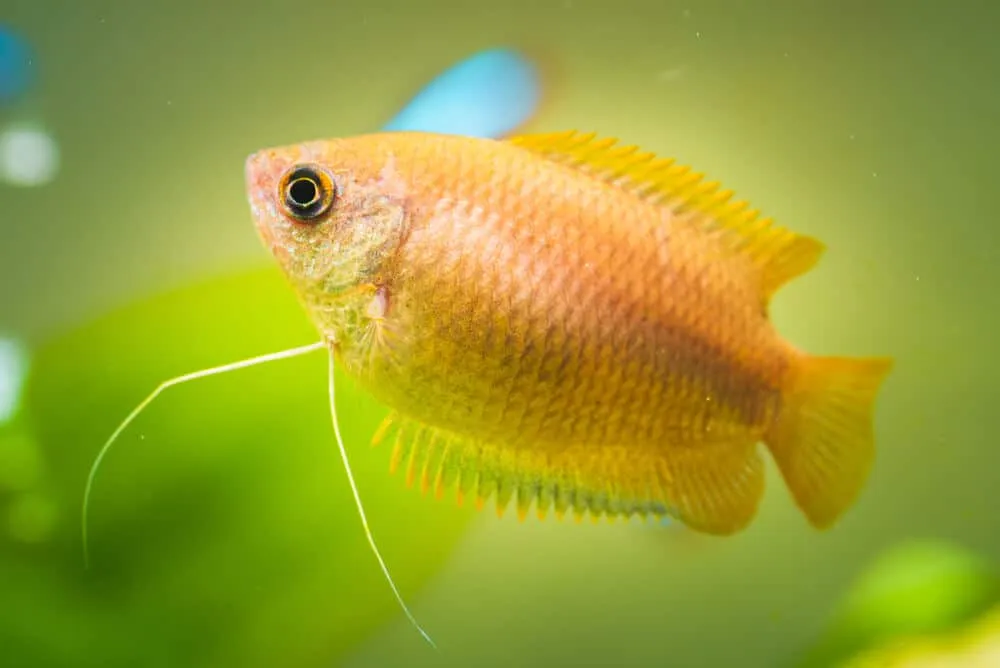Bala Shark: Care, Tank Setup and Suitable Tankmates

Have you ever wondered about the intriguing creature known as the Bala Shark? This unique species, scientifically known as the Balantiocheilos melanopterus, is a popular choice among fish enthusiasts. With its sleek silver body and distinctive vertical black stripes, the Bala Shark has captured the hearts of many aquarium owners. Despite its name, this fascinating fish is not a shark at all, but rather a member of the minnow family. In this brief article, we will explore the fascinating characteristics of the Bala Shark and shed light on why it is an excellent choice for your aquatic collection.
Physical Description
Size and Shape
The Bala Shark, also known as the Silver Shark or Tricolor Shark, is a stunning freshwater fish that can grow quite large. As a juvenile, it may only measure around three inches in length, but as it matures, it can reach an impressive length of up to 14 inches. Its body shape is streamlined and elongated, resembling that of a shark, which is how it got its common name. The Bala Shark has a slender body with a slightly arched back, and it possesses a large dorsal fin that adds to its graceful appearance.
Coloration
The Bala Shark is most commonly recognized for its silver coloration, which is where it derived its alternative name, the Silver Shark. However, it also showcases a beautiful tricolor pattern with hints of black and yellow. Its back and upper sides exhibit a silver hue, while its flanks have a touch of black, and its belly is a stunning golden shade. These colors blend harmoniously, creating a visually striking fish that adds elegance to any aquarium.
Natural Habitat
Geographical Distribution
Native to Southeast Asia, the Bala Shark can primarily be found in river basins scattered across Thailand, Cambodia, Malaysia, and Indonesia. It thrives in the freshwater systems of these regions, particularly in larger rivers and streams with moderate currents. The Bala Shark is a migratory species, often moving to different parts of the river systems depending on the season and availability of resources.
Aquarium Environment
When replicating their natural habitat in an aquarium setting, it is important to provide ample swimming space for the Bala Shark due to their active nature and large size. A tank with a minimum capacity of 75 gallons is recommended for a small group of Bala Sharks, and larger tanks are advisable for larger groupings. Additionally, it is crucial to simulate a river ecosystem by incorporating strong filtration to maintain optimal water quality. The Bala Shark is accustomed to moderate water flow, so the addition of a powerhead or strong filter can help mimic its natural habitat.
Behavior
Social Nature
Bala Sharks are highly social creatures and should ideally be kept in groups of at least five or more individuals. They have a gregarious nature, and being in a group offers them a sense of security and alleviates stress. When kept in solitary confinement, these fish often become reclusive and display signs of distress. By maintaining a group of Bala Sharks, you can observe their fascinating communal behavior and witness their dynamic interactions.
Activity Level
One of the most captivating aspects of the Bala Shark is its vibrant and lively nature. These fish are known for their constant movement and energetic behavior. They are skilled swimmers and spend the majority of their time exploring their surroundings and patrolling the aquarium. The Bala Shark’s activity level makes it a captivating fish to watch, bringing life and vibrancy to any aquatic environment.
Jumping Tendencies
It is essential to secure the aquarium lid when keeping Bala Sharks, as they have a propensity for jumping. Their agile bodies and natural behavior to navigate through flowing waters may lead them to attempt jumping out of the tank. To prevent any accidents or harm to the fish, a tightly-fitted lid or a mesh cover should be utilized to provide a secure barrier.
Diet
Carnivorous Diet
Bala Sharks are carnivores, meaning they primarily consume meat-based foods. In their natural habitat, they feed on small crustaceans, insects, and zooplankton. To ensure that they receive adequate nutrition in captivity, it is crucial to offer them a varied diet that consists of high-quality commercial foods specifically formulated for carnivorous fish.
Feeding Requirements
To meet the feeding requirements of Bala Sharks, it is recommended to provide them with a mix of live or frozen foods and high-quality pellet or flake foods designed for carnivorous fish. Foods such as brine shrimp, bloodworms, and daphnia are rich in essential nutrients and can be a valuable addition to their diet. Feed them two to three times daily, offering an amount that they can consume within a few minutes. Always monitor their eating habits and adjust the amount of food accordingly.
Tank Setup
Tank Size
Due to their large size and active nature, Bala Sharks require a spacious tank to thrive. The minimum tank size recommended for a small group of Bala Sharks is 75 gallons, but larger tanks are preferable to accommodate their growth and provide ample swimming space. Remember, the more Bala Sharks you plan to keep, the larger the aquarium should be.
Water Conditions
In their natural habitat, Bala Sharks inhabit rivers and streams with relatively fast currents and pristine water conditions. To replicate this environment, it is essential to maintain good water quality in the aquarium. They prefer slightly acidic to neutral water with a pH range of 6.5 to 7.5. The water temperature should be kept between 75 to 82°F (24 to 28°C). Regular water changes, along with efficient filtration, will help ensure a healthy and stable environment for your Bala Sharks.
Aquascape
When setting up the aquarium for your Bala Sharks, it is recommended to provide a natural and spacious environment. A sandy substrate can mimic their riverbed habitat, and the addition of smooth rocks and driftwood can create hiding spots and visual interest. Dense vegetation, such as java ferns or Amazon swords, can be incorporated to provide shade and cover. Additionally, the driftwood can facilitate the growth of beneficial biofilm, which the Bala Sharks will find appealing to graze upon.
Tank Mates
Suitable Tank Mates
Bala Sharks are generally peaceful fish and can coexist with a variety of other community fish. They thrive when housed alongside other active species that can withstand their energetic nature. Suitable tank mates for Bala Sharks include other robust fish like Tiger Barbs, Rainbowfish, or Tinfoil Barbs. It is important to choose fish of similar size to prevent potential aggression or predation.
Incompatible Tank Mates
Although Bala Sharks are typically peaceful, it is essential to avoid housing them with small or slow-moving fish that may be mistaken for food. They have a predatory instinct and could target smaller tank mates, causing harm or stress to them. Avoid keeping them with delicate or timid fish, as they may be intimidated by the Bala Sharks’ size and activity level.
Breeding
Breeding Environment
Bala Sharks breeding in captivity can be a challenging endeavor due to their natural migratory and elusive behavior. Creating a suitable breeding environment is crucial to encourage spawning. This can involve providing the fish with a separate breeding tank, incorporating plants for egg deposition, and closely monitoring water conditions.
Egg-Laying Behavior
When Bala Sharks are ready to spawn, the female will release a large number of eggs, and the male will vigorously fertilize them. The eggs are adhesive and will stick to the vegetation or any available surface within the breeding tank. After spawning, the parents should be removed from the tank to prevent them from consuming the eggs or fry.
Care for Fry
The eggs will typically hatch within 24 to 48 hours, and the newly hatched fry will attach themselves to plants or surfaces using an adhesive organ called a “holdfast.” To care for the fry, it is advisable to provide them with infusoria or finely crushed fry food until they are large enough to eat small live or frozen foods. Maintain clean water conditions and ensure appropriate filtration for the growing fry’s healthy development.
Common Health Issues
Velvet Disease
Velvet Disease, also known as Oodinium, is a parasitic infection that causes a gold or rust-colored dust-like appearance on the fish’s skin. It can cause lethargy, loss of appetite, and breathing difficulties. Regular water changes, maintaining good water quality, and prompt treatment with appropriate medications can help combat Velvet Disease.
Fin Rot
Fin Rot is a bacterial infection that affects the fins and causes them to deteriorate over time. This can lead to frayed or discolored fins, as well as open sores. Maintaining clean water conditions, avoiding overcrowding, and promptly addressing any signs of fin damage can help prevent and treat Fin Rot.
Ich
Ich, medically known as Ichthyophthirius multifiliis, is a common parasitic infection that affects many freshwater fish, including Bala Sharks. It manifests as small white spots on the fish’s body and fins, resembling grains of salt. Ich can cause irritation, flashing, and loss of appetite. Treating the tank with appropriate medications, raising the water temperature, and ensuring optimal water quality are necessary steps to combat Ich.
Hole in the Head
Hole in the Head, or Head and Lateral Line Erosion (HLLE), is a condition characterized by the development of holes, pits, or erosion along the fish’s head or lateral line. It is believed to be caused by nutritional deficiencies or poor water conditions. Maintaining a varied and nutritious diet, regular water changes, and providing a stress-free environment can help prevent and treat Hole in the Head.
Tips for Care
Water Quality Maintenance
Regular water changes are vital to maintain optimal water quality and prevent the onset of various health issues. Aim for weekly water changes of 25-30% to remove accumulated waste, toxins, and maintain stable water parameters. Regularly test the water for ammonia, nitrite, and nitrate levels and ensure they remain within acceptable ranges.
Regular Feeding Schedule
Establishing a consistent feeding schedule is essential for the overall health and well-being of your Bala Sharks. Feed them two to three times daily, offering an amount of food that they can consume within a few minutes. Monitor their feeding habits and adjust the portion sizes accordingly to prevent over or underfeeding.
Observing Behavior Changes
Regular observation of your Bala Sharks’ behavior is crucial in detecting any signs of illness, stress, or aggression. Changes in swimming patterns, appetite, coloration, or unusual hiding behavior can indicate an underlying issue. If you notice any significant behavior changes, promptly investigate and address the matter to ensure the health and happiness of your fish.
Conclusion
The Bala Shark is a captivating freshwater fish that offers beauty, elegance, and vibrancy to any aquarium. With their striking coloration, energetic nature, and captivating behavior, they are sure to be a joy to observe and care for. By providing them with suitable tank conditions, a varied diet, and compatible tank mates, you can ensure the health and well-being of these remarkable fish. Remember to maintain good water quality, establish a regular feeding schedule, and always keep an eye out for any behavior changes that may signal a potential health issue. With proper care and attention, your Bala Sharks will thrive and bring endless delight to your underwater world.




